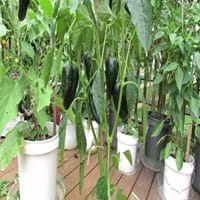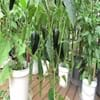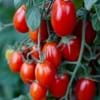Life Span
Perennial
Annual
Origin
Mexico, Central America, South America
South America
Types
Pasilla Bajo Pepper, Ancho Magnifico pepper
Not Available
Number of Varieties
Not Available
Habitat
Fertile bottom land
gardens, Moist Soils
USDA Hardiness Zone
4-12
Not Available
Sunset Zone
A1, A2, A3, H1, H2, 1a, 1b, 2a, 2b, 3a, 3b, 4, 5, 6, 7, 8, 9, 10, 11, 12, 13, 14, 15, 16, 17, 18, 19, 20, 21, 22, 23, 24
A1, A2, A3, H1, H2, 1a, 1b, 2a, 2b, 3a, 3b, 4, 5, 6, 7, 8, 9, 10, 11, 12, 13, 14, 15, 16, 17, 18, 19, 20, 21, 22, 23, 24
Habit
Upright/Erect
Vining/Climbing
Flower Color
Yellow, Gold
Yellow, Gold
Flower Color Modifier
Bicolor
Bicolor
Fruit Color
Yellow, Orange
Yellow, Orange
Leaf Color in Spring
Dark Green
Green, Light Green
Leaf Color in Summer
Purple, Gray Green
Green, Dark Green
Leaf Color in Fall
No
Green, Dark Green
Leaf Color in Winter
Green, Dark Green
Not Available
Leaf Shape
Oval
Heart-shaped
Plant Season
Not Available
Summer, Fall
Sunlight
Full Sun
Full Sun
Growth Rate
Fast
Very Fast
The pH of Soil
Acidic, Neutral
Neutral
Soil Drainage
Well drained
Well drained
Bloom Time
Not Available
Indeterminate
Tolerances
Drought
Drought
Where to Plant?
Container, Ground, Pot
Ground
How to Plant?
Seedlings
Seedlings
Plant Maintenance
Medium
Medium
Watering Requirements
Average Water Needs, Do Not over Water, Requires regular watering
Keep the ground moist but not water-logged, Requires consistently moist soil, Requires regular watering, Requires watering in the growing season, Water in the early morning hours
In Summer
Average Water
Lots of watering
In Spring
Moderate
Moderate
In Winter
Average Water
Average Water
Soil pH
Acidic, Neutral
Neutral
Soil Drainage Capacity
Well drained
Well drained
Sun Exposure
Full Sun
Full Sun
Pruning
Remove damaged leaves, Remove dead branches, Remove dead leaves, Remove dead or diseased plant parts, Remove deadheads
Prune after flowering
Fertilizers
All-Purpose Liquid Fertilizer
Apply 5-10-5 amounts, Nitrogen, Phosphorous, Potassium
Pests and Diseases
Red blotch
Red blotch
Plant Tolerance
Drought
Drought
Flowers
Insignificant
Showy
Flower Petal Number
Single
Single
Foliage Texture
Medium
Coarse
Foliage Sheen
Glossy
Matte
Attracts
Insects
Beetles, Bugs
Allergy
Skin irritation
Asthma, breathing problems, Itchiness, Nasal Congestion, Swelling, Swelling in the face
Aesthetic Uses
Not Used For Aesthetic Purpose
Not Used For Aesthetic Purpose
Beauty Benefits
Not Available
Good for skin and hair, Not Available, Skin cleanser, Skin Problems
Environmental Uses
Air purification
Air purification
Medicinal Uses
Anti-oxidant, Cold, Improve circulation, Swelling, Upset stomach, Weight loss
Anemia, Antibacterial, anti-cancer, cholesterol-lowering, Fertility, High blood pressure, Immunity, Liver problems, Prevention of convulsion, Regulates Blood Sugar
Part of Plant Used
Fruits
Fruits, Leaves, Seeds
Other Uses
Used As Food
Used As Food, Used as Ornamental plant, Used for its medicinal properties, Used in salads
Used As Indoor Plant
Yes
No
Used As Outdoor Plant
Yes
Yes
Garden Design
Container, Edible, Herb / Vegetable, Mixed Border, Tropical
Edible, Herb / Vegetable
Botanical Name
CAPSICUM annuum 'Guajillo'
CUCURBITA maxima 'Atlantic Giant'
Common Name
Chile Negro, Holy Mole Chile, Poblano Pepper
Atlantic Giant Pumpkin, Pumpkin
In Hindi
Poblano pepper plant
कद्दू
In German
Poblano Pfefferpflanze
Kürbis
In French
Poblano Pepper usine
Citrouille
In Spanish
planta de pimiento poblano
Calabaza
In Greek
φυτό πιπέρι poblano
Κολοκύθι
In Portuguese
Poblano planta da pimenta
Abóbora
In Polish
Poblano papryka roślin
Dynia
In Latin
Poblano piperis herba
cucurbita
Phylum
Magnoliophyta
Magnoliophyta
Class
Magnoliopsida
Magnoliopsida
Family
Solanaceae
Cucurbitaceae
Clade
Angiosperms, Asterids, Eudicots
Angiosperms, Eudicots, Rosids
Tribe
Capsiceae
Cucurbiteae
Subfamily
Solanoideae
Cucurbitoideae
Number of Species
Not Available
Season and Care of Poblano Pepper and Giant Pumpkin
Season and care of Poblano Pepper and Giant Pumpkin is important to know. While considering everything about Poblano Pepper and Giant Pumpkin Care, growing season is an essential factor. Poblano Pepper season is Not Available and Giant Pumpkin season is Not Available. The type of soil for Poblano Pepper is Loam and for Giant Pumpkin is Loam while the PH of soil for Poblano Pepper is Acidic, Neutral and for Giant Pumpkin is Neutral.
Poblano Pepper and Giant Pumpkin Physical Information
Poblano Pepper and Giant Pumpkin physical information is very important for comparison. Poblano Pepper height is 45.00 cm and width 90.00 cm whereas Giant Pumpkin height is 30.00 cm and width 500.00 cm. The color specification of Poblano Pepper and Giant Pumpkin are as follows:
Poblano Pepper flower color: Yellow and Gold
Poblano Pepper leaf color: Dark Green
Giant Pumpkin flower color: Yellow and Gold
- Giant Pumpkin leaf color: Green, Light Green
Care of Poblano Pepper and Giant Pumpkin
Care of Poblano Pepper and Giant Pumpkin include pruning, fertilizers, watering etc. Poblano Pepper pruning is done Remove damaged leaves, Remove dead branches, Remove dead leaves, Remove dead or diseased plant parts and Remove deadheads and Giant Pumpkin pruning is done Prune after flowering. In summer Poblano Pepper needs Average Water and in winter, it needs Average Water. Whereas, in summer Giant Pumpkin needs Lots of watering and in winter, it needs Average Water.





